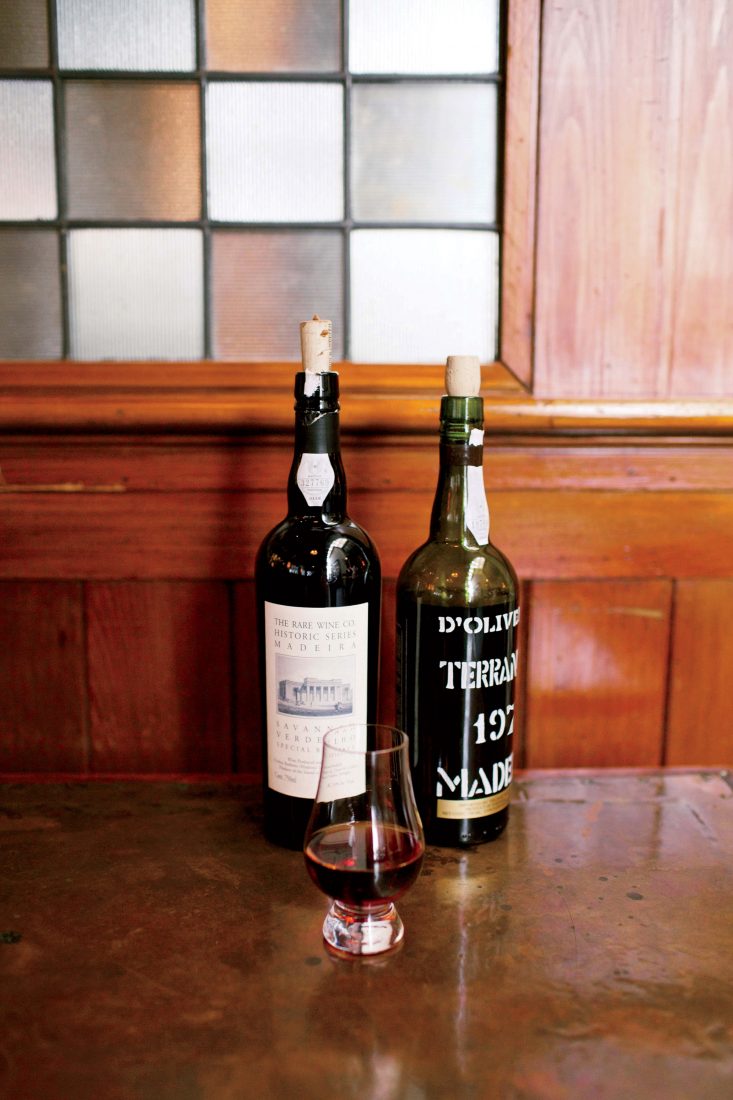Let’s have an argument. The question on the table—or in this case, the bar—is the identity of the South’s original drink. And by this I mean its original alcoholic drink, which is just one reason sweet tea is out of the running. I hear loud and rowdy cries for whiskey, but whiskey’s popularity didn’t really boom until almost the 1800s, when distillers discovered the mellowing effect of aging in charred oak barrels. Not until distillers in Kentucky and Tennessee perfected the process did the link between the South and whiskey—especially bourbon—take hold. No, the South’s original drink—the first beverage that proto-Southerners embraced as their own, and the first to become associated with the region—was a wine (yeah, a wine) that you may never have tasted (but should, immediately): Madeira.
Madeira is an idiosyncratic, brandy-spiked wine from an island of the same name that sits roughly 360 miles off the coast of Morocco. The island’s Portuguese discoverers planted grapevines beginning in the fifteenth century, eventually producing lackluster fortified wine that ships would pick up en route to the American colonies. But something weird happened to the wine on its transatlantic voyages. The brutal shake ’n’ bake conditions in the ships’ sauna-like cargo holds actually improved it—more accurately, transformed it—giving Madeira an outrageously distinctive and complex caramel flavor that became an instant stateside hit.
Nowhere more so than in the South. “This was the sole beverage of the Southern nobility,” says John Mitchell, a sommelier at Stella in New Orleans. “Whole social clubs were established around drinking it.” Juniata College history professor James Tuten says Madeira was a particular darling of lowland rice planters, for whom it “was one of the absolute favorite luxuries.” Why? The very same heat that provided the wine its alluring character—to mimic the effects of those voyages, Madeira is nowadays stored in heated, 100-degree-plus rooms for six months or longer—must have also endeared it to Southerners. Unlike, say, red table wine, Madeira tastes refreshing in the tropical heat, and doesn’t suffer from sweltering storage. Mitchell credits the wine’s high levels of acidity and sugar for that refreshing quality, which might also explain its affinity to the Southern palate—acidity and sugar, of course, being the defining characteristics of that later blockbuster Southern drink, cola. Charleston, Savannah, and New Orleans became epicenters of Madeira connoisseurship. Farther up the Eastern Seaboard in Virginia, Thomas Jefferson was one of the wine’s most ardent fans; during his presidency alone, by Tuten’s calculations, Jefferson spent the current equivalent of $42,000 on Madeira.
Then it disappeared: poof. In 1851, a mildew epidemic struck the island of Madeira, just a decade before the Union’s naval blockade during the Civil War strangled the crucial Southern market. Then came a devastating blight of phylloxera on the island, followed later, back in the States, by Prohibition. Madeira was like some punch-drunk boxer struggling to stay on its feet against an onslaught of blows; eventually it just rolled out of the ring. Subsequent generations of Southerners were mostly familiar with Madeira as a gravy ingredient for pork chops, if they were familiar with it at all.
Cue the comeback story, which has been a couple of decades in the making. In the same way chefs such as Sean Brock have been raiding the historical pantry to resurrect lost flavors and ingredients, so too have sommeliers like Mitchell and pioneering importers—not to mention the island’s producers, who’ve been replanting the island with old grape varieties—been reviving Madeira. At Husk, Brock’s vintage-South restaurants in Charleston and Nashville, a range of Madeiras anchors the wine list, and, in the antebellum manner, they’re often paired with food courses rather than relegated to after-dinner sipping. “There’s definitely been a resurgence,” says Mitchell, whose wine list at Stella includes a half dozen Madeiras, including some from a series of blends from the Rare Wine Company that pay homage to essential Southern ports such as Charleston, Savannah, and New Orleans. “People are starting to understand and enjoy it more and more every day,” he says. “It’s truly America’s beverage, and the South’s.”








